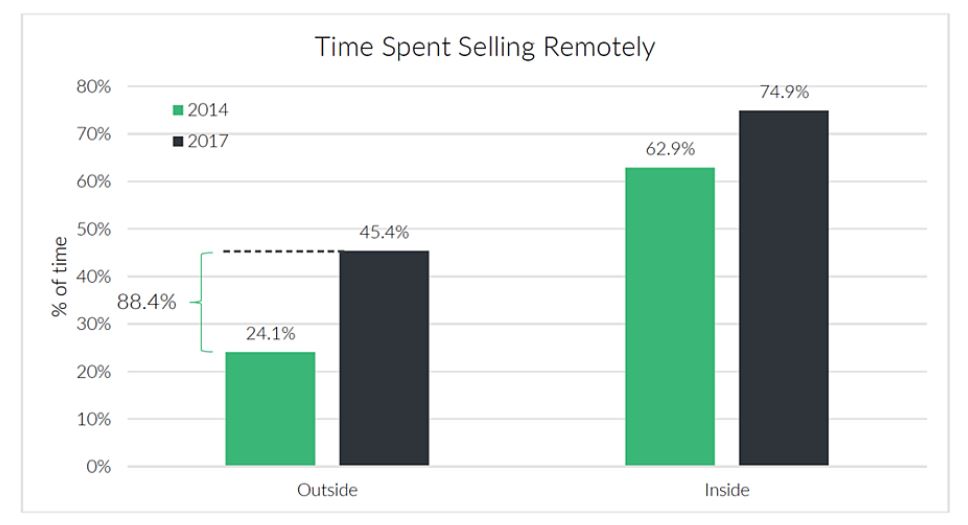Outside or Inside Sales?
How to integrate both sales strategies to maximize your full potential

It's often argued these two strategies are at odds with one another. But, in today's market, the two roles are blending -- and both have become a vital part of sales organization structure.
Inside sales offers a leaner, more automated approach, while outside sales capitalizes on the in-person interaction and power of face-to-face communication. So, which go-to-market should you choose? Let's explore the inside sales vs. outside sales equation and study how each fits into modern sales teams.
Inside Sales vs. Outside Sales
Inside sales reps often sell remotely, typically from an office. And outside sales reps travel, brokering face-to-face deals. While outside sales reps likely have an employer with physical office space, these salespeople are meeting with prospects at trade shows, conferences, or speaking at industry events.
Out of the 5.7 million professional salespeople in the U.S., approximately 47.2% are inside sales professionals. Outside sales represents 52.8%.
What do inside sales reps do?
Since inside sales reps typically don't meet with prospects face-to-face, they leverage tools like phones, email, and virtual meetings to connect with potential customers.
Their schedule is more predictable, and they often have a target for the number of activities they accomplish each day (e.g., number of calls, meetings booked, proposals sent).
If you're interested in becoming an inside sales rep, you'll need to have a deep understanding of your product. Unlike an outside sales rep who can give an in-person demo, inside sales reps need to have the ability to explain the functionality and value of their product to customers during a cold call.
What do outside sales reps do?
Outside sales reps spend almost half their time (45.4%) selling remotely -- an 88.4% increase from 2014. They often sell at industry events, conferences, or speaking engagements. This type of sales position is a good fit for those who like to manage their own schedules and work independently.
The activities and tools inside and outside sellers use are so similar (e.g.,CRM, email, social media), there's really no more inside versus outside sales anymore.
It's all sales.

Sales Team Structures
If you haven't decided whether to hire inside or outside sellers on your team -- the answer will be frustrating: "It depends." It depends on what stage of development your company is in and what sales model you're using.
Invested Sales research analysis shows large organizations (revenue > $500M) are currently dominated by field sales reps (71.2%). However, we expect this number to decrease as more organizations adopt a hybrid or inside sales model.
Small organizations (revenue <$50M) have the highest percentage of inside sales reps (47%). Interestingly, large companies are continually adding inside sales and expect to see the biggest increase with 4.9% more inside sales reps in 2018.
In 2017, inside sales made up 43.5% of professional salespeople. But that number is expected to grow by 4.59% in 2019, as it moves towards sales teams reaching a 50/50 balance of inside and outside sellers.
The main reason for the continued move is that most companies report the ideal split to be nearly 50/50.
Data shows as companies grow, a pattern emerges in how they structure their sales organization. In a relational sales model -- with deal sizes over $32,000 -- certain roles emerge more than others.
In our research, the relational model started stronger with an outside sales team and a in sales development team. As revenue grew, we saw account roles split to provide better customer support. The inside sales and sales engineer teams each build a strong presence in this area.
To continue, the inbound function of partnering with marketing is strongest in conjunction with a renewals function to support the account management team. Lastly, the channel program is added at the end of the growth process.
Inside Sales vs. Outside Sales Salary
To retain top talent, companies need to pay market value for salespeople. Our study revealed the average base salary for inside sales account executives in the US is $42,833 with average on-target earnings (OTE) of $96,299.
Often, sales leaders believe outside reps bring more experience to a role, so they demand a higher base salary. According to our data, companies who had the majority of outside sales reps had a base salary that was 36% higher than inside sales.
Interestingly, the OTE for outside sales was only 9.2% higher. OTE should be an indicator of expected earnings, so inside sales positions actually earn relatively close to the same amount as outside sales.
Quota Attainment
We know only 60.9% of reps reach quota attainment each year. Interestingly, outside sales reps have a 29.6% higher quota on average than inside sales reps.
And, while there's certainly a long way to go before salespeople have 100% quota attainment, these are not lackluster results.
Better collaboration and communication between inside and outside sellers and marketing and sales, along with increased productivity (Thanks to AI) will significantly elevate sales performance in the future.
It's crucial many companies support inside and outside sales collaboration for increased chance to reach sales targets. While they're sometimes assigned territories based on specific roles (inside/outside), companies often allow inside sellers to close smaller value deals on their own -- and support the outside seller when working on key strategic accounts.
Inside and Outside Sales Activities
The sales profession is hard work, as we've already discussed. But who does it better, inside or outside sellers?
Sales organizations primarily made up of inside sales reps made 42.5% more dials, left 10.2% more voicemails and sent 8.8% more emails than organizations with primarily outside sales reps. They also focused more on social media, with 49% more social touches than outside sales reps. (18.1% vs 12.1%).
Overall, companies with sales teams dominated by inside sales reps have a 9.8% higher quota attainment than companies dominated by outside sales reps.
At the same time, there are other things to consider:
- Companies who have a majority of outside sales reps have a 30.2% higher close rate than companies who have a majority of inside sales reps.
- Deals worked by outside sales teams tended to be 130.2% bigger on average than those worked by inside sales teams.
Transactional Versus Relational Sales Models
Now, before you look at these numbers and fire your entire outside sales team, I should warn you they are the result of sales activities performed in specific sales environments.
Certain sales models, like the transactional sales model, with low-value deals and fast sales cycles, lend themselves to an inside sales model. A relational sales model, with high-value deals (over $35,000) and long sales cycles, will benefit from having outside sellers on your team.
Transactional Sales Model
- The seller tries to close a deal without attempting to form a relationship
- Small number of decision-makers (1-3)
- Fast sales cycle (<90 days)
- Small deal sizes (under $35,000)
Relational Sales Model
- Suited for companies with a large number of employees (<100)
- Build rapport with a large number of decision-makers (4+)
- Slow sales cycles (>90 days)
- Larger deal sizes (over $35,000)
Finally, when choosing a sales organizational structure, you'll always be at the whim of your customer. How do your customers prefer to be contacted? How do they allow you to close a deal? Can you close a $1m deal over the phone? Only your customer can decide that.
I don't believe there's a specific vertical, industry, or product where a field sales model is indispensable. Sure, there are industries that have a field sales model. But, this doesn't mean it's the optimal sales model in the current market.
What I've found is the outside (or field sales) model is common in industries that are slow to change. It's usually an issue of someone on the executive team saying: "Oh, well, we've always done it this way." We must find a way to break out of these traditions and find room for experimenting with new concepts.
The buyer of today is becoming more digitally savvy. As they're purchasing more goods for personal use on Amazon and other websites, they'll naturally expect this model to work seamlessly in the B2B environment as well.
You must be ready to meet them with a solid digital sales model -- and this means including inside sellers on your team.
There really is no manual when it comes to inside and outside sales. Companies are trying different models, testing different organizational structures and making sure they find the right fit for their product, their buyer, and their market. Find what's right for you.
Let Invested Sales be the balance in your organizations sales structure!